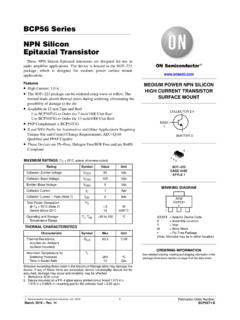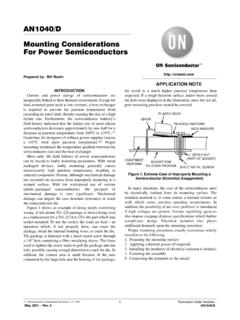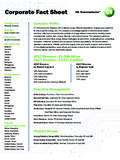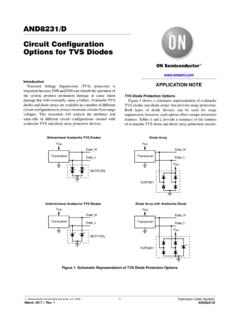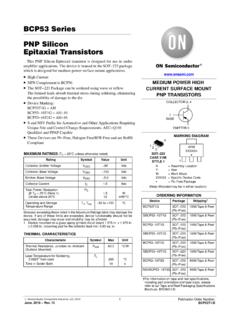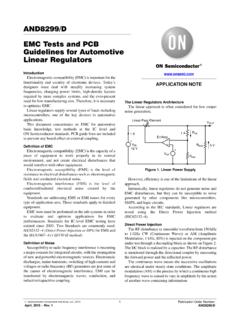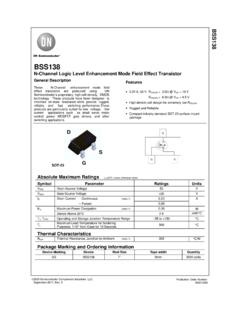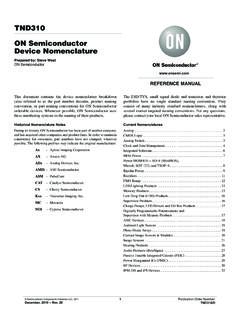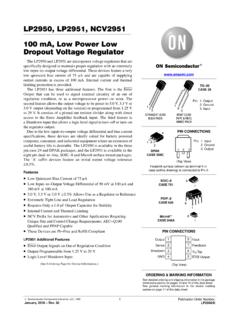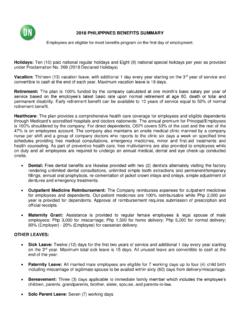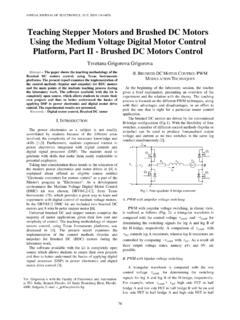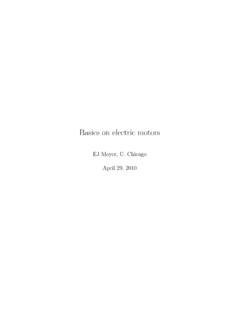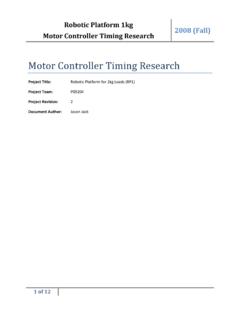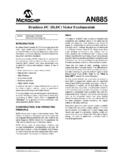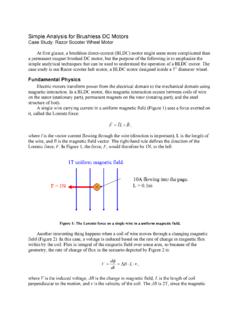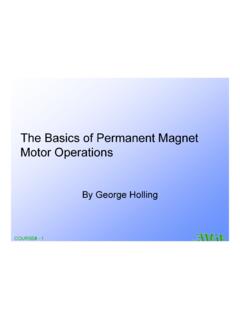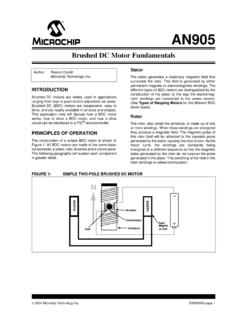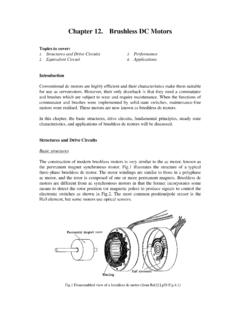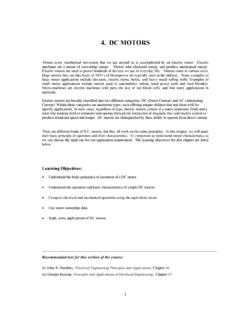Transcription of TND6041 - DC Motor Driver Fundamentals
1 Semiconductor Components Industries, LLC, 2014 March, 2014 Rev. 11 Publication Order Number: TND6041 /DTND6041/DDC Motor DriverFundamentalsINTRODUCTIONE lectric motors have been with us since the early 19thcentury, when Hungarian physicist nyos Jedlik producedthe first continuously rotating DC Motor , made possible byhis invention of the commutator. By the early 20th centuryelectric motors revolutionized industry and agriculture andmade possible such labor saving consumer applications aswashing machines and refrigerators. Today electric motorspower everything from giant cruise ships to implantablemedical are many different types of motors, but they allcontain three basic elements: an armature, a field magnet,and a commutator.
2 The armature is a conductive coil that inmost cases is attached to a rotating shaft and surrounded bya field magnet, which can be either a field winding orpermanent magnets. Current passing through the armaturecreates a magnetic field that is opposed to the field current,resulting in an electromotive force (EMF) that causes theshaft to rotate, generating mechanical torque. Thecommutator is a set of contacts attached to the armature shaftthat keeps reversing the direction of current flow in thearmature as it turns, thus ensuring that the Motor continuesto motors are mechanically rather simple, the termsthat describe them can be confusing.
3 In mechanical termsthe rotating part of Motor is called the rotor; the stationarypart is the stator. In electrical terms the power producingpart of the Motor is called the armature; depending on thedesign the armature can be either the rotor or the stator. Thefield is a magnetic field component of the Motor ; again thiscan be either the rotor or the stator and it can be either anelectromagnet or a permanent magnet. In general literaturethese terms are often used interchangeably, which can are two basic types of DC motors: brushed andbrushless, with subsets of each (Figure 1). We ll discusseach in 1. Motor ComponentsBRUSHED DC MOTORSThe brushed DC Motor is the simplest and the earliestelectrical Motor design.
4 While it has a number ofdisadvantages, is inexpensive and is still used widely fortorque control and variable speed brushed DC Motor consists of a few simplecomponents: stationary stator composed of field coils(wound field) or two hemispherical permanent magnets(PM); an internal rotating armature consisting of two ormore coils connected to a segmented commutator which iscontacted by brushes connected to the DC power supply(Figure 2).DC power is conducted through the brushes andcommutator, and the current through the coil createsa magnetic field.
5 This field is opposite to the magnetic fieldof the permanent magnets in the stator, causing the armatureto rotate. Mechanical commutation changes the direction NOTETND6041/ current and a rotational motion is generated. Witha two-pole Motor the commutator causes the current toreverse in direction every half cycle, causing the Motor tocontinue to speed of the Motor is directly proportional to thevoltage applied, while the torque is proportional to thecurrent. You control the speed of a brushed DC Motor bysimply varying the voltage applied to it; to reverse it, justreverse the polarity of the applied voltage; and to stop it turnoff the 2.
6 brushed PM DC MotorBrushed DC motors have some advantages over otherdesigns: They are simple and inexpensive; They don t require complex drive electronics; Their speed is a direct, linear function of the armaturevoltage; Because of their simplicity and low cost typically halfthe cost of brushless DC motors of the same size design cycles are , they re not without some notable drawbacks: The brushes tend to wear out because of continuousfriction. The brushes and springs need replacing fromtime to time; The commutator needs periodic cleaning orreplacement; Arcing is ever present and causes EMI that can interferewith nearby electronics; The rotor s inertia may be an issue, and the commutatormakes the Motor larger than its brushless counterpart; Heat generated by coil rotation is always an environment in which a brush DC Motor is used canalso greatly affect the lifetime of the Motor .
7 Dry, warmenvironments may increase the wear of the brushes andquicken the breakdown of the commutator and a brush DC Motor in a cooler environment alongwith external cooling by forced air may cause the Motor toperform better. However, extreme drops in temperature canpotentially increase the viscosity of the lubricants, causingthe Motor to run at a higher brushed DC MotorsThere are two basic types of brushed DC motors: thosewhose stator consists of field coils and those that usepermanent magnets in the stator instead. There are threetypes of wound-field coils (Figure 3): Shunt wound, in which the field coils are connected inparallel with the armature coils via the brushes(Figure 3A); Series wound, in which the field coils are in series withthe coils in the armature (Figure 3B); and Hybrid, with separate field coils where one is in seriesand the other is in parallel with the armature coils(Figure 3C).
8 Figure 3. Field Coils: (A) Shunt, (B) Series, (C) HybridMfMfMf1f2AB CBrushed PM DC MotorsUntil the development of neodymium magnets brushedpermanent magnet (PM) DC motors were only able tohandle small loads. Today they are commonly used in fairlylarge commercial and industrial applications and aredominant in fractional-horsepower applications. Incommercial use since 1886 they are still the most commonlyused DC motors in the brushed DC MotorsDriving brushed DC motors is straightforward inprinciple but not quite so simple in practice. For the simplestsmall applications you can run the Motor directly froma power source and use a potentiometer to control the speedand a switch to reverse its direction.
9 If the Motor is to be partof an embedded application you need a Driver IC and somecontrol 4 is a block diagram of ON Semiconductor sLB1938FA single-channel, forward/reverse brush motordriver IC that provides low-saturation outputs for use inlow-voltage applications. The Motor is driven by an Hbridge that is protected by spark killer diodes, since this isa brushed Motor . The logic circuitry in the control blockdetermines the speed and direction of the Motor as dictatedby the CPU. The LB1938FA provides forward, reverse,brake, and standby modes controlled by two input s designed for use in notebook computers, digital cameras,cell phones, and other portable 4.
10 Motor ComponentsCPUIN1IN2S-GNDVCCCONTROL BLOCKMOUT1 OUT2P-GNDC1 = to 10 mF60 kW60 kW80 kW80 kW1234867 BRUSHLESS DC MOTORSW here brushed DC motors have a very long history,BLDC motors only came into their own in the 1960s. BLDC motors are considerably more efficient than brushed DCmotors; they last a lot longer; and they deliver more torqueper moving the permanent magnets to the rotor and drivingthe field coils with transistors you can eliminate the brushesin DC motors along with their disadvantages (inrunnerconfiguration, the most common). Alternatively thearmature coils can form a fixed core with the permanentmagnets revolving around them and driving the Motor shaft(outrunner).
